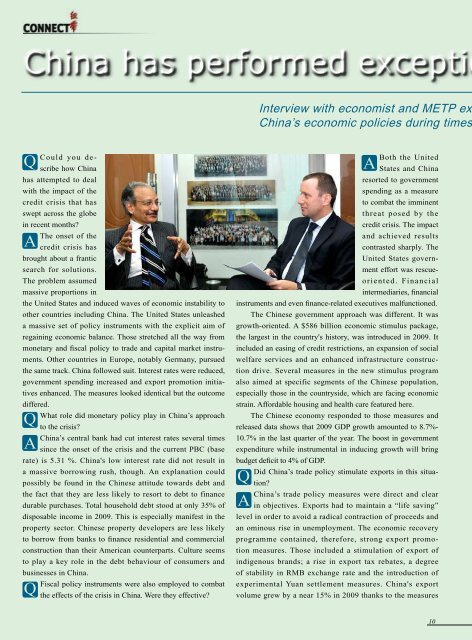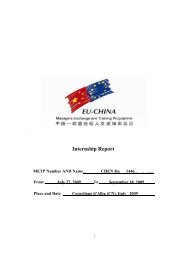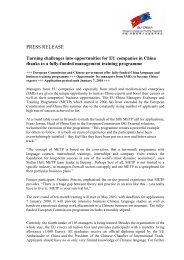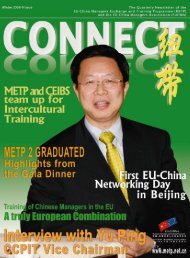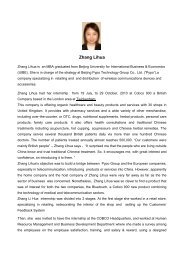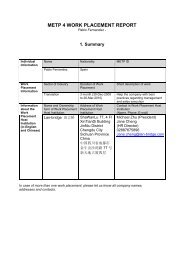Download - EU-China Managers Exchange and Training Programme
Download - EU-China Managers Exchange and Training Programme
Download - EU-China Managers Exchange and Training Programme
Create successful ePaper yourself
Turn your PDF publications into a flip-book with our unique Google optimized e-Paper software.
<strong>China</strong> has performed exceptio<br />
Interview with economist <strong>and</strong> METP exp<br />
<strong>China</strong>’s economic policies during times<br />
Could you describe<br />
how <strong>China</strong><br />
has attempted to deal<br />
with the impact of the<br />
credit crisis that has<br />
swept across the globe<br />
in recent months?<br />
The onset of the<br />
credit crisis has<br />
brought about a frantic<br />
search for solutions.<br />
The problem assumed<br />
massive proportions in<br />
the United States <strong>and</strong> induced waves of economic instability to<br />
other countries including <strong>China</strong>. The United States unleashed<br />
a massive set of policy instruments with the explicit aim of<br />
regaining economic balance. Those stretched all the way from<br />
monetary <strong>and</strong> fiscal policy to trade <strong>and</strong> capital market instruments.<br />
Other countries in Europe, notably Germany, pursued<br />
the same track. <strong>China</strong> followed suit. Interest rates were reduced,<br />
government spending increased <strong>and</strong> export promotion initiatives<br />
enhanced. The measures looked identical but the outcome<br />
differed.<br />
What role did monetary policy play in <strong>China</strong>’s approach<br />
to the crisis?<br />
<strong>China</strong>’s central bank had cut interest rates several times<br />
since the onset of the crisis <strong>and</strong> the current PBC (base<br />
rate) is 5.31 %. <strong>China</strong>'s low interest rate did not result in<br />
a massive borrowing rush, though. An explanation could<br />
possibly be found in the Chinese attitude towards debt <strong>and</strong><br />
the fact that they are less likely to resort to debt to finance<br />
durable purchases. Total household debt stood at only 35% of<br />
disposable income in 2009. This is especially manifest in the<br />
property sector. Chinese property developers are less likely<br />
to borrow from banks to finance residential <strong>and</strong> commercial<br />
construction than their American counterparts. Culture seems<br />
to play a key role in the debt behaviour of consumers <strong>and</strong><br />
businesses in <strong>China</strong>.<br />
Fiscal policy instruments were also employed to combat<br />
the effects of the crisis in <strong>China</strong>. Were they effective?<br />
Both the United<br />
States <strong>and</strong> <strong>China</strong><br />
resorted to government<br />
spending as a measure<br />
to combat the imminent<br />
threat posed by the<br />
credit crisis. The impact<br />
<strong>and</strong> achieved results<br />
contrasted sharply. The<br />
United States government<br />
effort was rescueoriented.<br />
Financial<br />
intermediaries, financial<br />
instruments <strong>and</strong> even finance-related executives malfunctioned.<br />
The Chinese government approach was different. It was<br />
growth-oriented. A $586 billion economic stimulus package,<br />
the largest in the country's history, was introduced in 2009. It<br />
included an easing of credit restrictions, an expansion of social<br />
welfare services <strong>and</strong> an enhanced infrastructure construction<br />
drive. Several measures in the new stimulus program<br />
also aimed at specific segments of the Chinese population,<br />
especially those in the countryside, which are facing economic<br />
strain. Affordable housing <strong>and</strong> health care featured here.<br />
The Chinese economy responded to those measures <strong>and</strong><br />
released data shows that 2009 GDP growth amounted to 8.7%-<br />
10.7% in the last quarter of the year. The boost in government<br />
expenditure while instrumental in inducing growth will bring<br />
budget deficit to 4% of GDP.<br />
Did <strong>China</strong>’s trade policy stimulate exports in this situation?<br />
<strong>China</strong>’s trade policy measures were direct <strong>and</strong> clear<br />
in objectives. Exports had to maintain a “life saving”<br />
level in order to avoid a radical contraction of proceeds <strong>and</strong><br />
an ominous rise in unemployment. The economic recovery<br />
programme contained, therefore, strong export promotion<br />
measures. Those included a stimulation of export of<br />
indigenous br<strong>and</strong>s; a rise in export tax rebates, a degree<br />
of stability in RMB exchange rate <strong>and</strong> the introduction of<br />
experimental Yuan settlement measures. <strong>China</strong>'s export<br />
volume grew by a near 15% in 2009 thanks to the measures<br />
10


